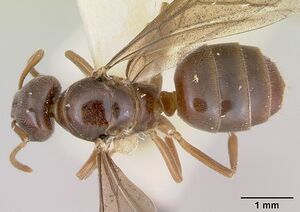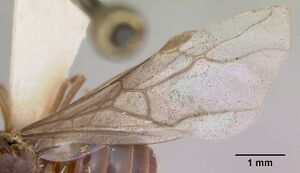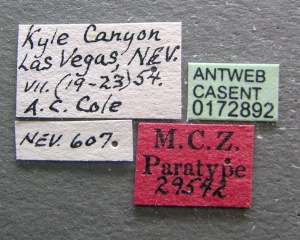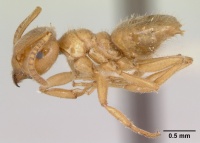Lasius nevadensis
| Lasius nevadensis | |
|---|---|

| |
| Scientific classification | |
| Kingdom: | Animalia |
| Phylum: | Arthropoda |
| Class: | Insecta |
| Order: | Hymenoptera |
| Family: | Formicidae |
| Subfamily: | Formicinae |
| Tribe: | Lasiini |
| Genus: | Lasius |
| Section: | flavus clade |
| Species group: | umbratus |
| Species: | L. nevadensis |
| Binomial name | |
| Lasius nevadensis Cole, 1956 | |
This species, known only from Nevada and Utah, has been found only a handful of times. The nests used when describing this species were in unshaded, compact soil in an open, dry, pine and spruce forest. Two of the nests were beneath large stones; the other four were marked only by entrance holes surrounded by a scattering of soil particles. Five of the nests contained males or queens as well as workers, those nests with one sex not containing the other. A mass mating flight was in progress at dusk and was observed until its termination at darkness. The species has also been found in a rocky, grassy herbaceous open north-facing slope surrounded by a Ponderosa pine-White Fir forest 30-50' tall. This location had rocky, sandy soil and workers were under a rock in partial shade at the edge of gap at the base of a steep slope.
Identification
In Wilson's (1955) key to the Nearctic forms of Lasius, the worker of this species will run to couplet 14 where it would appear to fit best Lasius vestitus. Dr. M. R. Smith has kindly compared workers of this species with types of his Lasius pilosus which has been synonymized by Wilson (1955, p. 173) under L. vestitus. Dr. Smith has reported (in litt.) that the specimens definitely do not represent his L. pilosus. Among other characteristics of difference, L. pilosus is larger, less shining, and has longer and more abundant pilosity.
The worker differs from that of Lasius subumbratus in its more sparse gastric pilosity, gastric hair measurements, the numerous standing hairs on the lateral tibial surfaces, the smaller body size, and the darker color. From Lasius umbratus, the worker differs markedly in the presence of standing hairs on the femora and tibiae, the longer hairs on the preapical region of the first gastric tergite, and the darker body color. The queen differs from that of L. subumbratus largely in the suberect and much shorter pilosity on the preapical region of the first gastric tergite. It can be separated immediately from the queen of L. umbratus, which it resembles rather closely, by the presence of standing hairs on the femora and tibiae.
Keys including this Species
Distribution
Latitudinal Distribution Pattern
Latitudinal Range: 36.294687° to 36.25816667°.
| North Temperate |
North Subtropical |
Tropical | South Subtropical |
South Temperate |
- Source: AntMaps
Distribution based on Regional Taxon Lists
Nearctic Region: United States (type locality).
Distribution based on AntMaps
Distribution based on AntWeb specimens
Check data from AntWeb
Countries Occupied
| Number of countries occupied by this species based on AntWiki Regional Taxon Lists. In general, fewer countries occupied indicates a narrower range, while more countries indicates a more widespread species. |

|
Estimated Abundance
| Relative abundance based on number of AntMaps records per species (this species within the purple bar). Fewer records (to the left) indicates a less abundant/encountered species while more records (to the right) indicates more abundant/encountered species. |

|
Biology
Castes
Images from AntWeb
    
| |
| Paratype of Lasius nevadensis. Queen (alate/dealate). Specimen code casent0172891. Photographer April Nobile, uploaded by California Academy of Sciences. | Owned by MCZ, Cambridge, MA, USA. |
   
| |
| Paratype of Lasius nevadensis. Worker. Specimen code casent0172892. Photographer April Nobile, uploaded by California Academy of Sciences. | Owned by MCZ, Cambridge, MA, USA. |
Nomenclature
The following information is derived from Barry Bolton's Online Catalogue of the Ants of the World.
- nevadensis. Lasius (Chthonolasius) nevadensis Cole, 1956a: 26 (w.q.m.) U.S.A.
Type Material
- Holotype, worker, Kyle Canyon, Charleston Mountains, near Las Vegas, Nevada, 7700 ft., United States, 36°16′N 115°38′W / 36.26°N 115.63°W, 23 July 1954, A.C. Cole, Cole Coll. No. NEV-607, A.C. Cole Collection.
- Paratype, workers, queens, males, Kyle Canyon, Charleston Mountains, near Las Vegas, Nevada, 7700 ft., United States, 36°16′N 115°38′W / 36.26°N 115.63°W, 23 July 1954, A.C. Cole, A.C. Cole Collection.
- Paratype, 11 workers, 2 queens, 3 males, Kyle Canyon, Charleston Mountains, near Las Vegas, Nevada, 7700 ft., United States, 36°16′N 115°38′W / 36.26°N 115.63°W, 23 July 1954, A.C. Cole, Museum of Comparative Zoology.
A large series from six populous colonies (NEV-595, 604, 605, 607, 608, and 622) where collected. The holotype and large series of paratype workers, males, and females are in the A.C. Cole Collection. Paratypic series of all castes have been deposited in the U. S. National Museum, the Museum of Comparative Zoology (Harvard), the American Museum of Natural History, and in the collections of W. S. Creighton and R. E. Gregg.
Description
- Holotype worker
Head length, 0.90 mm.; head width, 0.84 mm.; eye length, 0.16 mm.; eye width, 0.13 mm.; pronotal width, 0.62 mm.; scape length, 0.76 mm.; scape index (scape length x 100/head width), 90; maximum width of hind tibia at its midlength, 0.14 mm.
Maximum length of preanal hairs of first gastric tergite approximately 0.08-0.09 mm., or about 0.70 times as long as the maximum width of the hind tibia at its midlength; all hairs suberect, not dense enough to overlap one another. Eyes with about 50 facets. Scapes with dense, predominantly decumbent (but a few standing) hairs. Petiolar scale rather high; viewed from behind, the sides convex, broadest below the middle, the crest rather deeply but broadly emarginate, the corners rounded; viewed in profile, the apical portion flattened and the crest sharp, anterior surface convex, posterior surface flattened; lateral and apical borders with a sparse fringe of erect hairs which are as long as the longest preapical ones of the first gastric tergite. Gastric pubescence sparse, appressed, scattered, not obscuring the shining surface. Head, thorax, petiole, and appendages brownish yellow; gaster lightly infuscated.
- Queen
Head length, 1.20 mm.; head width, 1.26 mm.; scape length, 1.00 mm.; scape index, 80; eye length, 0.32 mm.; eye width, 0.24 mm.
Pilosity on anterior three gastric segments dense, very short (maximum length, 0.03-0.04 mm.), yellowish, predominantly suberect. Thoracic hairs less numerous, straight, some on the scutum comparatively long (0.15- 0.17 mm.)-, erect and suberect. All surfaces of femora and tibiae with numerous,' suberect hairs. Head with numerous, straight, scattered, erect and suberect hairs (maximum length on vertical and occipital regions, 0.10-0.11 mm.). Entire body with a rather long, dense, silvery, appressed pubescence (highly overlapping at the tips) which only partially conceals the shining body surface. Head, thorax, petiole, and gaster a rather deep, yellowish brown, the appendages much lighter.
- Male
Head length, 0.73 mm.; head width, 0.68 mm.; eye length, 0.19 min.; eye width, 0.16 mm.; scape length, 0.49 mm.; scape index, 72; pronotal width, 0.76 mm.; length of thorax and petiole combined, 1.57 min.; maximum width of hind tibia at its midlength, 0.11 mm.
Petiolar scale in profile rather thin, the crest acute, viewed from behind the apical border broadly and slightly excised, lateral margins with a few, rather long, erect hairs; anterior surface broadly convex and with numerous suberect hairs, posterior surface nearly flat. Gastric pilosity resembling that of the holotype; maximum length of preanal hairs on first gastric tergite, 0.07 mm. Maximum length of hairs on posterior two-thirds of clypeus, 0.13 inm.; maximum length of both scutal and scutellar hairs, 0.14 mm. Hairs on vertex and occipital border numerous, uneven in length, maximum length about 0.16 mm.
- Variation in paratype series.
Workers vary as follows: head length, 0.81-0.95 mm.; head width, 0.79-0.87 mm.; scape length, 0.73-0.79 mm.; scape index of the extremes, 90 and 92; eye length, 0.14-0.15 mm.; eye width, 0.11-0.14 mm.; pronotal width, 0.59-0.62 mm.; greatest width of hind tibia at its midlength, 0.10-0.14 mm.; extreme length of preapical hairs of first gastric tergite, 0.08-0.09 mm. Head width and associated scape index of a large series of females varied from 1.20 mm. (83) to 1.26 mm. (83). Head width of a large series of males varied from 0.65 mm. to 0.73 mm.; the scape index of the extremes being 71 and 74.
References
- Boudinot, B.E., Borowiec, M.L., Prebus, M.M. 2022. Phylogeny, evolution, and classification of the ant genus Lasius, the tribe Lasiini and the subfamily Formicinae (Hymenoptera: Formicidae). Systematic Entomology 47, 113-151 (doi:10.1111/syen.12522).
- Cole, A. C., Jr. 1956a. Studies of Nevada ants. II. A new species of Lasius (Chthonolasius) (Hymenoptera: Formicidae). J. Tenn. Acad. Sci. 31: 26-27 (page 26, worker, queen, male described)
References based on Global Ant Biodiversity Informatics
- La Rivers I. 1968. A first listing of the ants of Nevada. Biological Society of Nevada, Occasional Papers 17: 1-12.
- Wheeler G. C., and J. Wheeler. 1986. The ants of Nevada. Los Angeles: Natural History Museum of Los Angeles County, vii + 138 pp.

